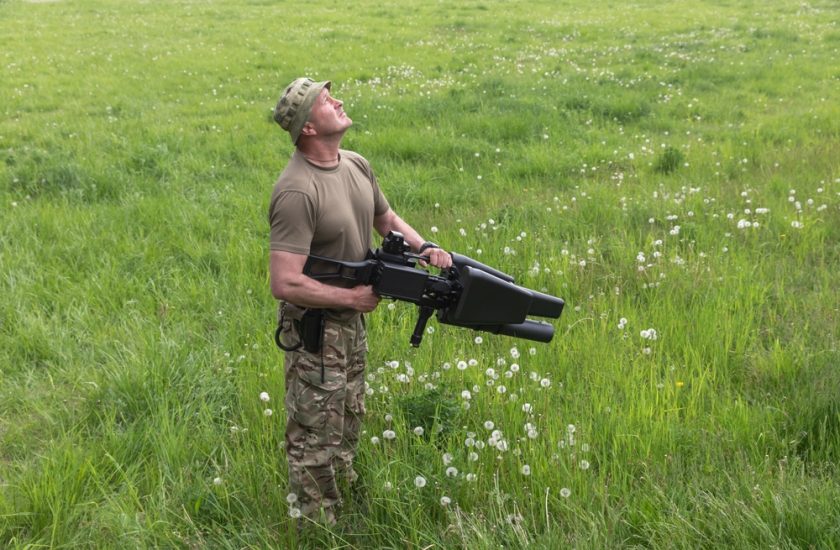By Philip Butterworth-Hayes
The last year has seen an unprecedented increase in counter-UAS spending (C-UAS), deployment and technology capability improvement, far beyond the estimates of most forecasters. On the civil side, new concepts such as C-UAS-as-a-service are maturing, where equipment manufacturers provide and integrate the hardware and software while end-users choose between several service levels depending on their budget. The first integrated UAS traffic management/C-UAS ecosystem technologies have entered the market; but while C-UAS capabilities have made exponential increases in capability there has been far less progress in developing the institutional arrangements for identifying which bodies should have the mandate to mitigate the problem of rogue drones once they have been identified.
In the military domain, the war in Ukraine has become a war of attrition, where the onus is on deploying large numbers of affordable front-line tactical C-UAS systems to defeat early generation UAVS, rather than reacting to new drone threats which have suddenly appeared on the battlefield, such as autonomous swarming attacks. Although some commentators see the emergence of drone-on-drone combat in Ukraine as the start of a new era of air warfare, most government investment in new C-UAS capabilities – in the public domain at least – does not appear to be in intercept drones or net capture systems but in areas such as direct energy or C-UAS anti-swarm capabilities. Our updated Global Counter-UAS Directory and Buyer’s Guide lists seven major new direct energy programmes launched in the last year; we have added 32 new programmes to the database, 29 updates and a new section C-UAS uncrewed ground vehicles. The directory now contains more 330 companies and programmes.
The development of C-UAS as-a-service for both civil and military customers is transforming the industry in many ways. Drone detection systems based in the cloud are making layered capabilities more affordable and scalable, obviating the need for airports and sports arena to buy expensive hardware and long-term software update contracts. As many cities around the world start work on developing drone and eVTOL services requiring a C-UAS capability the timing for the introduction of these services is propitious, although it remains to be seen what level of service delivery will satisfy regulators in their requirements for these ecosystems to be both safe and secure.
According to Statistica
“Civilian C-UAS hardware costs USD5 million for municipal airspace customers, with an annual subscription cost of USD1.7 million in 2020. Other primary end-users of counter-drone solutions within the civilian market include airports, nuclear power plants, prisons, the oil & gas industry, and enterprise airspaces.”
In the USA US DoD Joint Counter-small Unmanned Aircraft Systems Office (JCO) has accepted or recommended Rafael, SAIC and Liteye Systems, DroneShield and Black Sage as C-sUAS As A Service (CaaS) partners.
Wide-of-the-mark industry forecasts
At the start of 2023 Black Sage Technologies announced it has been awarded an indefinite-delivery/indefinite-quantity (IDIQ) contract for C-UAS systems from the US Air Force, with a contract value of up to USD900 million over a five-year period with options to extend up to ten years. According to Unmanned Airspace C-UAS contract award data, the US Department of Defense has awarded sales contracts of over USD1 billion in the last five months alone and poured several millions of dollars into furthering laser air defence research.
As most C-UAS contract sales data is confidential it is notoriously difficult to obtain exact costs of systems, as each sale varies considerably. According to the JCO: ground-based aerial denial systems should cost less than USD15,000 per drone engaged and for a hand-held capability, systems should cost less than USD37,000 per unit. These are still substantial amounts. And with current rates of DoD spending, the average estimate of the C-UAS market for 2023 of USD1.76 billion, taken from seven recent market forecasts, looks like a serious underestimate. The global annual expenditure rates of civil and military C-UAS systems, plus government investment in research and development, far more likely to be around the USD2.2 billion mark for 2023 and at the upper end of growth forecasts.
For more analysis and information please visit our Global Counter-UAS Directory and Buyer’s Guide
(Image: Kyiv, Ukraine. A serviceman holds a C-UAS jammer purchased with funds raised during a charity concert in Toronto, Canada. Image: Shutterstock)




